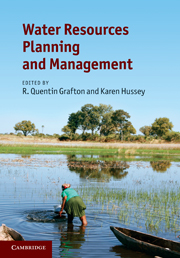Book contents
- Frontmatter
- Contents
- List of contributors
- Foreword
- Preface
- Acknowledgements
- Introduction
- Part I Understanding ‘water’
- Part II Water resources planning and management
- 8 Water law and the search for sustainability: a comparative analysis
- 9 Tackling the global water crisis: unlocking international law as fundamental to the peaceful management of the world's shared transboundary waters – introducing the H2O paradigm
- 10 Risk and uncertainty in water resources planning and management: a basic introduction
- 11 Collaboration and stakeholder engagement
- 12 Capacity building and knowledge sharing
- 13 Adaptive and integrated management of water resources
- 14 Gender and integrated water resource management
- 15 Environmental flows: achieving ecological outcomes in variable environments
- Part III Water resources planning and management: case studies
- Contributors
- Index
- References
13 - Adaptive and integrated management of water resources
from Part II - Water resources planning and management
Published online by Cambridge University Press: 05 August 2011
- Frontmatter
- Contents
- List of contributors
- Foreword
- Preface
- Acknowledgements
- Introduction
- Part I Understanding ‘water’
- Part II Water resources planning and management
- 8 Water law and the search for sustainability: a comparative analysis
- 9 Tackling the global water crisis: unlocking international law as fundamental to the peaceful management of the world's shared transboundary waters – introducing the H2O paradigm
- 10 Risk and uncertainty in water resources planning and management: a basic introduction
- 11 Collaboration and stakeholder engagement
- 12 Capacity building and knowledge sharing
- 13 Adaptive and integrated management of water resources
- 14 Gender and integrated water resource management
- 15 Environmental flows: achieving ecological outcomes in variable environments
- Part III Water resources planning and management: case studies
- Contributors
- Index
- References
Summary
Introduction
The global water sector is entering a period of profound change as it pursues evidence-based responses to a host of emerging global, regional, national, and local challenges. Simply listing the attendant issues fails to reveal the full picture. Aging infrastructure, demographic change and migration, lack of full-cost pricing, emerging contaminants, the drive for energy efficiency, affordability issues, and the fact that huge swathes of the global population still do not have access to safe water and effective sanitation – all are major concerns. Add to all this the uncertainties imposed by climate change and the inertia imposed by physical legacy (engineered) and governance systems, and you have an intricate web of problems competing for resources and attention.
Communities all over the world are seeking interventions which achieve a multiplicity of ambitious outcomes – such as improved quality of natural water bodies, high quality and reliably delivered water for human use, and reduced greenhouse gas emissions. Such objectives, and correspondingly aggressive performance targets for managed systems, pursue the promise of sustainable water management. In many ways, climate change epitomises the challenges facing the water sector and provides a compendium of multi-faceted challenges, appropriate responses to which need to be sensitive to history, location, and circumstance.
- Type
- Chapter
- Information
- Water Resources Planning and Management , pp. 292 - 310Publisher: Cambridge University PressPrint publication year: 2011
References
- 13
- Cited by

